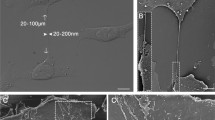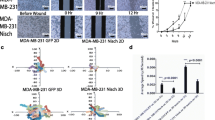Abstract
In histopathological sections, it is frequently observed that carcinoma cells invade the stroma as coherent cell nests rather than single cells. We have called this type of movement "cohort migration (CM)" and developed an in vitro model, in which human colon carcinoma cells move as coherent cell sheets when stimulated with hepatocyte growth factor/scatter factor (HGF/SF). In this CM model, localized release from cell–cell adhesion at the lower portion of cells is essential for cell movement. Its mechanism was investigated in this study with special reference to the E-cadherin/catenin complex (Ecc) and IQGAP1. IQGAP1 is a target molecule of Cdc42 and Rac1 and negatively regulates the Ecc-based cell–cell adhesion by dissociating α-catenin, a key molecule that links Ecc to actin cytoskeleton, from Ecc. In our study, the amount of IQGAP1 bound to Ecc increased in migrating cells in association with a decrease in the α-catenin level in Ecc. In accordance with this, IQGAP1 showed a shift from the cytosol to the membrane fraction. Moreover, confocal laser microscopic study demonstrated the localization of IQGAP1 at the membranes of the lower portion of migrating cells, where cell–cell adhesion was specifically disrupted during CM. Furthermore, when HGF/SF-induced CM was enhanced with pre-coated extracellular matrix (ECM) components, the level of IQGAP1 in Ecc increased more than that caused by HGF/SF alone. On the contrary, when CM was inhibited by interrupting cell–ECM interaction, the level of IQGAP1 in Ecc did not increase despite HGF/SF stimulation. Taken together, these results indicate close association of IQGAP1 with localized disruption of cell–cell adhesion during CM and that modulation of CM by cross-talk between signals induced by HGF/SF and cell–ECM interactions also involves IQGAP1-related mechanisms.
Similar content being viewed by others
Author information
Authors and Affiliations
Additional information
Electronic Publication
Rights and permissions
About this article
Cite this article
Shimao, Y., Nabeshima, K., Inoue, T. et al. Complex formation of IQGAP1 with E-cadherin/catenin during cohort migration of carcinoma cells. Virchows Arch 441, 124–132 (2002). https://doi.org/10.1007/s00428-002-0603-3
Received:
Accepted:
Published:
Issue Date:
DOI: https://doi.org/10.1007/s00428-002-0603-3




